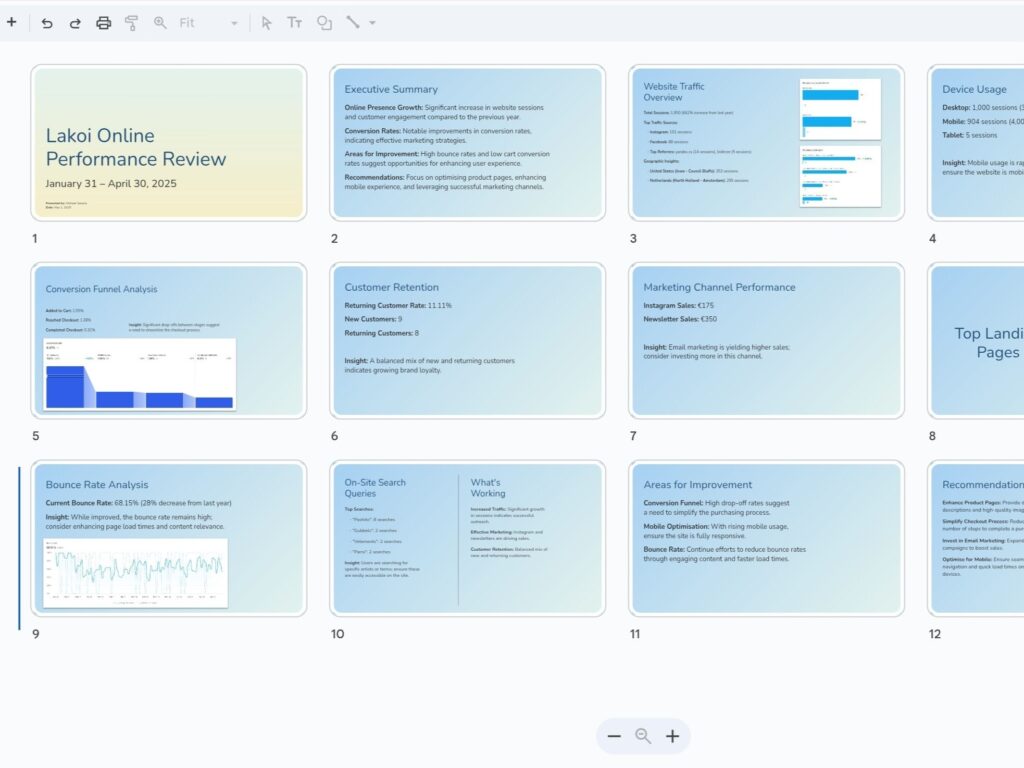
Recently, I collaborated with a client to help them optimise their online strategy — supporting them in understanding how their data could be used to improve planning, content effectiveness, and ultimately complete more online purchases. Helping clients improve their online presence is rarely just about design; it’s about enabling them to understand their users, their data, and their brand identity.
The client, Lakoi, is a framing shop and art gallery based in the Netherlands, with a rich clientele of returning customers in-store. However, they had maintained an online presence for a few years through their Shopify website (www.lakoi.nl) and platforms like Instagram, Facebook, and monthly newsletters, yet with little return on investment (ROI) online. I wanted to help them understand how they could grow their digital business using AI tools — enabling an insight-driven, efficient collaboration without the need for a full technical team.
Understanding the Challenges
Lakoi struggled to make sense of their analytics; they didn’t know which metrics truly mattered or how their site’s layout was affecting conversions across desktop and mobile. Their branding also felt somewhat scattered, and their content lacked clarity in what it was trying to achieve. Without an in-house analyst or developer, they needed support across strategy, UX, and technical know-how to refine their messaging and digital structure.
Their newsletters were engaging but lacked a logical strategy to drive readers towards making a purchase. While the website generated small business-level traffic, the abundance of content often distracted users, confusing their journey and leading to drop-offs before completing purchases. Visually, the site felt busy, and lacked a coherent user flow that would naturally guide customers towards transactions.

How I Tackled It
I began by exploring the Shopify analytics dashboard, which provides accessible yet powerful data points for small businesses. I reviewed three months’ worth of data (quarterly results), focusing on:
- Identifying the best-performing months across seasons
- Understanding the most used devices (desktop vs mobile)
- Analysing user traffic sources
- Highlighting the most visited pages and most common search terms
- Tracking add-to-cart behaviours by visitor location
- Identifying dead links and 404 errors impacting user experience
All these were crucial indicators of their site’s performance. I compiled the findings and used ChatGPT to help translate the technical results into a clear, plain-language Google Slides presentation, making the insights easily digestible. By connecting related data points into a meaningful narrative, I helped Lakoi clearly see who their customers were and how they were engaging with their online content.
Improving the UX and Content Strategy
Once the analytics review was complete, we sat down to discuss the site’s UX and layout. Data revealed that their customers were evenly split between desktop and mobile usage, meaning both experiences needed to be equally optimised.
We focused on improving:
- The header and footer, to make key content easier and faster to find
- Removing redundant links positioned too closely together
- Refining UX writing to reduce confusion and improve link clarity
- Closing the loop between marketing content and purchases — ensuring Instagram posts, newsletters, and blog articles linked directly to products whenever possible
Through AI support, I also advised on improving their tone and visual consistency. Using ChatGPT, I shared techniques for crafting more enticing closing paragraphs that encouraged users to move naturally towards product pages. This was particularly valuable as the client initially lacked experience in closing a sales pitch within their content.
Additionally, ChatGPT helped Lakoi improve their translations between Dutch and English, offering more authentic, contextually accurate phrasing than simple direct translations from Google Translate.

The Role of AI in Enhancing My Workflow
The impact of using AI within my workflow was irreplaceable. It allowed me to optimise my time effectively and maintain productivity without delays that would typically occur without immediate access to developers or analysts.
I wanted to work smarter — not harder — to deliver insights quickly so the client could act fast on improvements. AI filled critical knowledge gaps without undermining my UX expertise; rather, it amplified how clearly and efficiently I could explain and implement solutions.
Whether navigating Shopify settings, interpreting analytics, or making front-end code adjustments, ChatGPT enabled me to maintain momentum, make informed decisions in real-time, and deliver immediate, tangible value. Particularly when adjusting UI components and page layouts, AI provided the technical reassurance needed to execute changes successfully, without waiting for additional technical support.
Results and Reflections
The Lakoi team was thrilled. They not only gained a clearer vision for how their site could better function, but they also felt significantly more confident in managing and growing their online business moving forward.
For me, this project reaffirmed that AI can be a powerful design ally — one that unlocks knowledge and speed when it matters most. Small businesses don’t always require full-scale teams to achieve meaningful progress. What they truly need is guidance, clear strategy, and the right tools to help them succeed cost-effectively.
For designers working solo or without large teams, AI tools like ChatGPT offer a new way to stay resourceful. The key is knowing how to ask the right questions and pairing AI’s insights with your own design intuition.
Curious how you can use AI in your work? Reach out to me over on LinkedIn.